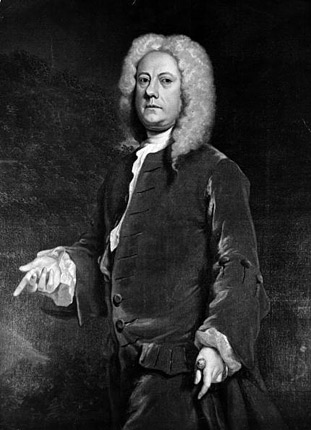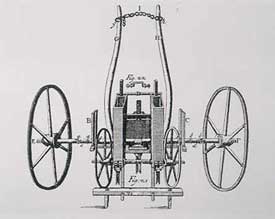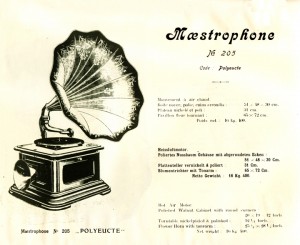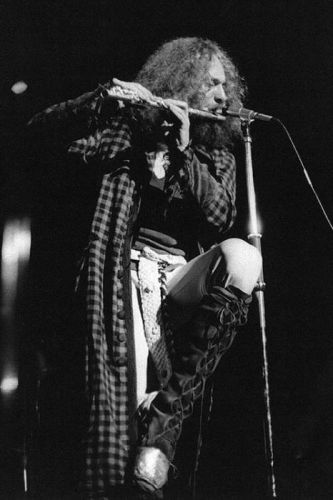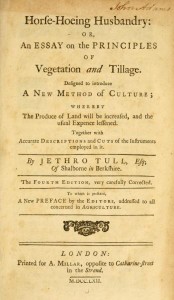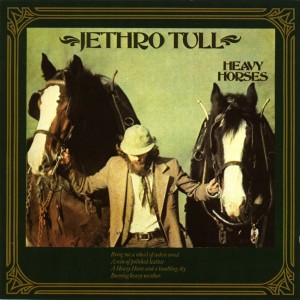Most people knew Jethro Tull had been around forever, but more than three centuries??
Oh. You mean the actual British dude, Mr. Tull, whom the progressive band was named after? (Wait, so that isn’t the singer’s name?) Quite an arbitrary choice, though certainly more cerebral than many of its era (Strawberry Alarm Clock, anyone?); and considering one of the early choices was Candy Coloured Rain, I think we can all appreciate that less acid-addled minds prevailed.
So who was this Jethro Tull and why is he important, aside from being on the cover of this album? Well, do the words seed drill mean anything to you?
Eventually, as agricultural improvement became fashionable, more interest began to be taken in Tull’s ideas. While several other mechanical seed drills had also been invented, Tull’s complete system was a major influence on the agricultural revolution and its impact can still be seen in today’s methods and machinery.
Suffice it to say, this was the iPod of its day. Arguably, the Agricultural Revolution would have taken longer to reach its full…flowering without Mr. Tull, and for that we can be grateful. No Agricultural Revolution, no Industrial Revolution. No Industrial Revolution, no electricity. No Electricity, no phonograph. No Phonograph…well, you get the picture. Without Jethro Tull…no Jethro Tull!
After three impressive albums, Tull signalled that they were around to stay with the release of Aqualung in 1971, an ambitious quasi-concept album that dealt with organized religion and man’s inhumanity to man. The title track (which features one of the great rock guitar solos of all time courtesy of Martin Barre) and “Locomotive Breath” became, and remain, FM radio staples. It is (as is often the case with “classic” albums) the somewhat lesser-known tunes that retain their true staying power. The one-two acoustic punch of “Cheap Day Return” and “Mother Goose” are archetypes of a sort; the kind of whimsical British folk that Tull perfected: the songs seem straightforward and pleasant enough (and they are) but are cut by their topical, and occasionally unsettling, lyrical import. This is Anderson’s calling card, and nowhere is it in better effect than the one minute and twenty-four seconds of perfection entitled “Cheap Day Return”. In astonishingly succinct and effective fashion Anderson deals with his own alienation, offers a sardonic appraisal of his own budding super-stardom (What a laugh!), and his father’s imminent death, all in a song that sounds innocuous as a nursery rhyme.
They were on top of the world (and the charts) in ’72 when Thick As A Brick became the first pop album comprised of one continuous song to reach a widespread audience. The concept may have been audacious, but the music is miraculous: this is one of the handful of holy grails for prog-rock fanatics: the ones who bought this album on vinyl, then, and the brave souls who have no shame in their game, now. Simply put, many beautiful babies were thrown out with the bath water by hidebound critics (then, now) who were content to dismiss the more ambitious (pretentious!) works that certain bands were putting out as a matter of course in the early-to-mid ’70s. And by works I don’t mean this but I do mean this (at least side one). And for every one of these there was one of these. And before he (rightly) became a more mainstream iconoclast, Peter Gabriel was the driving force behind albums like this and this and especially this. As could correctly be said of any artistic era, it was the best of times and it was the worst of times.
Inevitably, Jethro Tull lost some of that same audience (more than a handful forever) with their next opus, the more challenging (and, upon initial listens, less rewarding) A Passion Play. It was a shame, then, and remains regrettable, now that folks don’t have the ears or hearts for this material, as it represents much of Anderson’s finest work. His voice would never sound better, and he was possibly at the height of his instrumental prowess: the obligatory flute, the always-impressive acoustic guitar chops and, for this album, the cheeky employment of a soprano saxophone: it is a gamble (and/or a conceit, depending upon one’s perspective) that pays off in spades. All of the above is amply demonstrated in the opening section, embedded below. Not for nothing is this considered the masterpiece of the Tull oeuvre amongst die-hard fans (an encomium that only adds fuel to the fire for the legion of Tull haters, snot running down their noses).
Tull plowed ahead, making music their own way, and cranked out an album per year through the entire decade. In another nice bit of art imitating history, Anderson recorded the second album of his “pastoral trilogy” (including the majestic Songs From The Wood and the fin de siecle-inspired Stormwatch), ’78’s Heavy Horses.
In 1731 he published his book, ‘The New Horse Hoeing Husbandry’, detailing his system and its machinery. It caused great controversy at the time, and arguments continued for another century before his eventual vindication.
We can hope that the scales of artistic justice will have a similar fate in store for Anderson, and that his tour de force (the title track) is fully vindicated in the eyes of critics and casual music fans everywhere (though it’s difficult to protest too much for an artist who has sold many millions of albums). Nevertheless, it’s an embarrassing commentary on how close-minded so many folks are that they probably have never even heard this song. Of course, the professionals who write most often about rock music in the ’70s are not known for their fondness of multisyllabic words and material that obliges a modest understanding of world history.
The early ’80s were not particularly kind to Tull (or, put another way, the Tull of the early ’80s was not particularly kind to fans), and after the synth-heavy Under Wraps, it seemed like the time might be right for Anderson to turn more of his attention to salmon farming. But the (sweet) dream was not yet over: toward the end of the decade Tull unleashed back-to-back albums that recalled some of the better work of the past while being (mostly) entrenched in the here-and-now. The best moments on Crest of a Knave (’87) and Rock Island (’89) stand (mostly) alongside the best work the band did in its prime.
Farm on the Freeway:
Strange Avenues:
The ’90s were a time when bands who made double-albums in the ’70s replayed that material, live, to the retro crowd, working that nostalgia circuit in very profitable fasion. To Tull’s credit, they still toured regularly, and also made new albums from time to time. To say the results were mixed indicates a generosity that only the most unfaltering fan would deny. Still, Anderson had a few tricks left in his codpiece (figuratively speaking), like the surprisingly satisfactory Divinities: Twelve Dances With God. As the title suggests, it is a musical meditation on faith (all different types). The topic alone is cause for critics who wrote for Creem and Rolling Stone in the ’70s to suffer a fresh outbreak of the Herpes they contracted while covering The Sex Pistols, but the material holds up.
As some may be surprised to know, Jethro Tull still roams the earth, and while new albums aren’t being produced at the former pace (based on their post-’95 output, this is a good thing for all involved), they are still playing to crowds who happily pay to see them. If Pete Townshend decided he did not, in fact, want to die before he got old, it seems fair play for Jethro Tull and their fans to keep living in the past.
